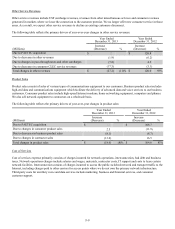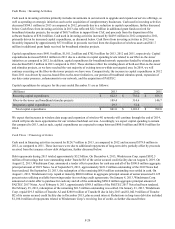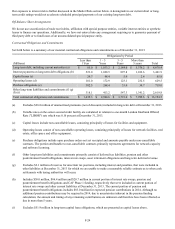Windstream 2013 Annual Report Download - page 154
Download and view the complete annual report
Please find page 154 of the 2013 Windstream annual report below. You can navigate through the pages in the report by either clicking on the pages listed below, or by using the keyword search tool below to find specific information within the annual report.
F-18
Internet Network Regulation
On January 14, 2014, the U.S. Court of Appeals for the D.C. Circuit vacated FCC regulations that had prohibited fixed service
providers from engaging in unreasonable discrimination and blocking lawful content when offering retail broadband service to
consumer, small business and other end user customers. The Court, however, did not overturn the FCC requirement that all
providers of broadband Internet access service disclose network management practices, performance characteristics, and
commercial terms of service. These FCC regulations had not caused a change in our existing procedures or operations.
State Regulation and Legislation
Local and Intrastate Rate Regulation
Most states in which our incumbent subsidiaries operate provide alternatives to traditional rate-of-return regulation for local
and intrastate services. We have elected alternative regulation for these subsidiaries in all states except New York. We continue
to evaluate alternative regulation options in New York.
State Universal Service
We recognize revenue from the receipt of state universal service funding in a limited number of states in which we operate. In
2013, we recognized $116.8 million in state USF revenue, which included approximately $78.2 million from the Texas USF.
These payments are intended to provide support, apart from the federal USF receipts, for the high cost of operating in certain
rural markets.
There are two high-cost programs of the Texas USF, one for large companies and another for small companies. In 2013, we
received $67.7 million from the large company program and $10.5 million from the small company program. The purpose of
the Texas USF is to assist telecommunications carriers with providing basic local telecommunications services at reasonable
rates to customers in high cost rural areas and to qualifying low-income and disabled customers. By order of the Texas PUC,
the Texas USF distributes support to eligible carriers serving areas identified as high cost, on a per-line basis. Texas USF
support payments are based on the number of actual lines in service and therefore are subject to reductions when customers
discontinue service or migrate to a competitive carrier. All service providers of telecommunications services in Texas contribute
to the Texas USF through the payment of a monthly surcharge collected from their customers.
Several states are currently conducting reviews of their universal service funds. In particular, the Texas PUC currently is
considering needs-based reforms that could adversely impact our Texas USF support, but pursuant to state legislation adopted
last year, any such reforms cannot take effect prior to 2017. We continue to work with the Texas PUC and industry members to
obtain a reasonable and more favorable outcome. We are not yet able to determine the financial impact of any future Texas USF
reform.
New Mexico, Oklahoma, and Pennsylvania are also considering reforms to their state universal service funds. We receive $8.4
million annually from the New Mexico fund, $3.4 million annually from the Oklahoma fund and $13.3 million annually from
the Pennsylvania fund. Reviews may address various aspects of the funds, including how they pertain to the basic retail rates of
eligible USF recipient companies and demonstration of the continuing need for support in high-cost areas. We cannot estimate
at this time the financial impact that would result from changes, if any, to these other state funds.
Intercarrier Compensation
There is an ongoing intercarrier compensation reform proceeding in New York. In that proceeding, it is alleged that our
intrastate switched access rates are excessive and should be reduced. We do not believe proposed reforms to intercarrier
compensation in New York would have a material impact on our operations if adopted.
























